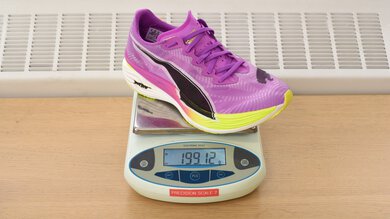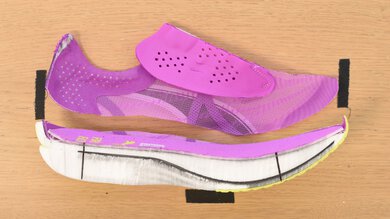The PUMA Deviate NITRO Elite 3 is a super shoe that stands out as a more refined and race-tuned sibling to the PUMA Deviate NITRO 3. While the Deviate NITRO 3 serves as a versatile tempo trainer suited for a range of workouts, the Elite 3 trims weight, sharpens the geometry, and replaces the midsole with full-length NITROFOAM ELITE for a snappier, more responsive ride built for speed on race day. A lightweight upper, full-length carbon plate, aggressive rocker, and reliable PUMAGRIP outsole round out the build, making it a strong option for races and a reliable companion for fast track sessions.
Our Verdict
The PUMA Deviate NITRO Elite 3 performs impressively in longer races thanks to its lightweight build, reliable energy return, and comfortable cushioning. Its foam offers consistent bounce without bottoming out late in the effort, and the full-length carbon plate helps maintain turnover deep into a race. That said, the shoe's lateral stability isn't the best, and the narrow platform makes it less forgiving for heel strikers or fatigued runners who deviate from an ideal form, especially late in the marathon.
NITROFOAM ELITE offers great energy return.
Lightweight.
Carbon plate.
Not the most stable super shoe.
The PUMA Deviate NITRO Elite 3 shines in shorter, faster races where its snappy toe-off, firm forefoot, and minimal weight create an efficient and fast ride. The aggressive rocker geometry works especially well for runners looking to maintain a quick cadence. It feels energetic and agile without being too harsh, which helps it stand out in the increasingly crowded super shoe market.
NITROFOAM ELITE offers great energy return.
Snappy forefoot.
Lightweight.
Carbon plate.
The PUMA Deviate NITRO Elite 3 has excellent energy return thanks to its NITROFOAM ELITE midsole made of A-TPU foam. Both the heel and forefoot offer solid rebound, making the shoe feel bouncy and responsive. This makes it a solid option for race efforts and high-speed sessions.
NITROFOAM ELITE offers great energy return.
The PUMA Deviate NITRO Elite 3 offers impressive cushioning. There's plenty of protection underfoot, with a midsole that provides shock absorption without feeling too mushy. It's not quite as plush as max-cushioned marathon super shoes, but it strikes a nice middle ground for most race-day needs.
Great amount of underfoot protection.
The lateral stability is a clear tradeoff of the PUMA Deviate NITRO Elite 3, like in most super shoes. With a narrow outsole, particularly at the arch, the shoe can feel a bit unstable when form begins to break down. This isn't too noticeable when you're locked into a forward-moving stride at speed, but runners who need more stability may find it unstable and too soft during slower efforts or when fatigued.
Carbon plate.
Narrow platform.
Soft heel foam.
Performance Usages
Changelog
-
Updated Dec 02, 2025:
We updated the Popular Running Shoe Comparisons to include the latest (fourth) iteration of the PUMA Velocity NITRO in PUMA's lineup.
- Updated Oct 28, 2025: We've converted this review to Test Bench 0.9, which adds a Forefoot Long Run Cushioning test to our performance section. Read more in our changelog.
-
Updated Oct 22, 2025:
We updated the Pros & Cons, Energy Return, Cushioning, Marathon Racing, Forefoot Cushioning, and Forefoot Energy Return boxes to align with the latest test bench and revised the side-by-side comparisons to keep the review accurate.
- Updated Oct 20, 2025: We've converted this review to Test Bench 0.8.2, which updates our methodology for the impact force range used in our compression tests to improve their accuracy. This also affects all usage and performance usage boxes using those compression tests as score components.
Check Price
Differences Between Sizes And Variants
We tested the PUMA Deviate NITRO Elite 3 in men's US size 9, as indicated on the label of our unit. The specific colorway shown here is Pure Magenta/Yellow Alert. This model is available in multiple colorways, including Glowing Red/PUMA Black, Sun Stream/Sunset Glow, and a Marathon Series edition in NITRO Blue/Fizzy Apple, which features design cues inspired by the World Marathon Majors. PUMA also released a special HYROX edition in Green Glare. Wide versions are not currently offered. Most of our review results are valid for all variants, though the design section applies only to the model we tested. We expect other size and gender variants to perform similarly.
Popular Running Shoe Comparisons
The PUMA Deviate NITRO Elite 3 is a well-balanced, no-fuss super shoe tuned to handle a wide range of distances and paces. While it's capable of tackling everything from 5Ks to marathons, it shines brightest in the middle of the spectrum, particularly at the half marathon, where its balance of cushioning and responsiveness really stands out. It's well-padded enough for longer races while still offering a snappy toe-off that makes it feel sharp over shorter efforts. One of its standout features is the substantial outsole grip, which sets it apart from many super shoes. Despite this added grip, it still keeps the weight impressively low, making it a versatile and race-ready option. The main trade-off is energy return; compared to top-tier super shoes like the Saucony Endorphin Elite 2 or adidas Adizero Adios Pro 4, the NITRO Elite 3 feels a bit less propulsive at top speed.
Within PUMA's lineup, the Deviate NITRO Elite 3 is positioned just below the PUMA Fast-R NITRO Elite 3, which is their most aggressive and lightweight super shoe for race day. There is also the PUMA Deviate NITRO 3, a plated super trainer designed for tempo runs and hard training sessions. Beneath that is the PUMA Velocity NITRO 4, a classic daily trainer built for comfort and durability in everyday mileage.
For more options, check out our recommendations for the best running shoes.
The adidas Adizero Adios Pro 4 and the PUMA Deviate NITRO Elite 3 are both lightweight carbon-plated super shoes, but they offer different strengths. The adidas delivers unmatched energy return and cushioning, making it a top-tier option for longer distances like the marathon. The Deviate NITRO Elite 3, on the other hand, feels even softer, which might feel a bit too plush for shorter events, but it's got a more accommodating fit, making it suitable for more foot shapes.
The PUMA Deviate NITRO Elite 3 and the Nike Alphafly 3 share a similar overall profile, but the forefoot pop and efficiency delivered by the Nike is unmatched, especially around marathon pace. The Puma features a higher heel-to-toe drop and a more accommodating fit, making it easier to wear for a broader range of foot shapes and potentially more comfortable over longer efforts.
The PUMA Deviate NITRO Elite 3 and the PUMA Deviate NITRO 3 cater to different types of runs despite their shared lineup. The Deviate NITRO 3 is a versatile tempo trainer, well-suited for daily miles and structured workouts, and features a firmer ride. In contrast, the Deviate NITRO Elite 3 is lighter, snappier, and more race-tuned, thanks to its full-length NITROFOAM ELITE midsole and more aggressive geometry. It's built for race-day speed, offering a more responsive and energetic feel with each stride. While the NITRO 3 can handle a variety of paces and is better for training durability, the Elite 3 is clearly the more performance-oriented option.
The Nike Vaporfly 4 and the PUMA Deviate NITRO Elite 3 are both super shoes optimized for events like a half marathon, offering lightweight builds and responsive rides. The Nike is significantly lighter, which can translate to better running economy and overall efficiency on race day. Meanwhile, the Puma features a roomier toebox, making it more accommodating and more comfortable for longer distances, like the full marathon. Both shoes have limited stability, but the Nike is slightly better in that aspect.
We've recently started buying and testing running shoes with a very data-oriented approach. While we're just getting started, our methodology already has dozens of tests to help you make the right purchasing decision for your needs. Not only do we use high-end equipment to gather objective data, but we also order multiple sizes of the same shoes for team members to be able to log in miles. This real-world testing is done at various paces and conditions, and with different types of workouts, to cover all the bases. This allows us to verify our results and ensure they align with what you might feel with a specific pair.
Test Results
The PUMA Deviate NITRO Elite 3 is impressively lightweight, in line with other elite racing shoes. Its lightweight upper helps reduce the overall weight, giving it a nimble feel and promoting quick turnover, which makes it ideal for runners focused on efficiency on race day. However, it's far from achieving the low weight of the Nike Vaporfly 4.
While still a performance-oriented model with the snug fit typical of racing shoes, this model features a slightly longer platform and a roomier toebox than most other super shoes. This results in a more accommodating fit that may work better for runners who find other carbon-plated models too restrictive up front.
The heel offers a strong bounce back on landing, with its A-TPU foam that springs back quickly. This gives the rearfoot a smooth and energetic transition towards the toe, helping you stay efficient and fast.
The forefoot delivers great propulsion during toe-off. It performs especially well at faster paces where the rocker and stiffness pair well with the energetic NITROFOAM ELITE midsole. Overall, it offers a satisfying and consistent return that supports both racing and hard intervals, but it doesn't quite achieve the efficiency level of top alternatives like the Nike Alphafly 3.
The heel protection is great in this model. It absorbs impact forces effectively across a wide range of runner weights and paces, with especially strong performance at higher forces. That makes it forgiving enough for runners who apply a lot of pressure upon each strike, where the heel foam compresses well, while still maintaining a performance-oriented ride.
Cushioning under the forefoot is also solid. There's enough protection to avoid making it feel too harsh at lower and medium forces, but runners who apply significant pressure when striking will sense more ground feel. It works best for midfoot to forefoot strikers who want to stay comfortable, but it doesn't offer the marathon‑level protection of a long‑distance specialist shoe like the Saucony Endorphin Elite 2.
The heel foam is soft, which can help with comfort but can also feel a bit unstable, especially for heel strikers. Runners needing more structure under the heel may find it too soft compared to alternatives like the Saucony Endorphin Pro 4.
The forefoot is firm and tuned for snappiness, helping deliver a fast, efficient toe-off. It strikes a good balance—rigid enough to promote high turnover and generate speed, but not too harsh for short to medium distances. It's great for runners who prefer a precise and dynamic forefoot when pushing the pace.

